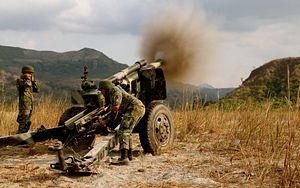Next month, the United States and the Philippines will begin the 34th iteration of their biggest annual bilateral exercise known as Balikatan. Though the interaction is only one of a multitude under the bilateral alliance, its evolution nonetheless has significance within the context of the broader evolution of the defense relationship amid the challenges posed by Philippine President Rodrigo Duterte.
As I have been noting in these pages, despite the initial uncertainties Duterte created for the U.S.-Philippine alliance with his quest to “rebalance” his country’s foreign alignments, the defense ties between the United States and the Philippines have actually not only been sustained in most areas, but even begun quietly expanding in some realms including in some exercises and the evolving shape of the U.S. military presence there (See: “Why the New US-Philippines Military Pact’s First Project Launch Matters”).
With the Balikatan exercises being one of the early victims in the Duterte era, bucking the trend of expansion seen in previous years under the leadership of former President Benigno Aquino III, all eyes will be on how the exercises evolve this year and the subsequent ones to assess the alliance, even though any one activity is a poor judge of a full spectrum of a relationship (See: “What Will US-Philippines Military Exercises Look Like in 2018?”).
With respect to bilateral interactions, how things turn out with respect to the Balikatan Exercises this year remains to be seen. Though the community engagement aspect of drills already begun last week, the actual exercises will take place only from May 7 to 18. And given previous sensitivities around the exercise and bilateral ties, it is no surprise both sides have been mum about unveiling much in the way of specifics. So far, public releases and statements by both sides have told us close observers of the U.S.-Philippine alliance already know: that exercises would focus on interoperability training events in areas such as counterterrorism, humanitarian assistance and disaster relief, and mutual defense, and that they will be focused in several provinces in Luzon.
A more meaningful assessment of where Balikatan stands will need to await more specifics closer to the start of the exercises. This includes not only things like the number of troops participating in the exercise relative to the previous year, which is often the subject of headlines, but also, more substantively, the kinds of activities and scenarios that are carried out in various components. Indications are that certain engagements previously downgraded or not publicly emphasized, including live training events, are expected to take place this year.
On the regional component of the exercise, the picture is clearer. As I have noted before, one of the important but still underappreciated facts about Balikatan is that the exercise has evolved from a purely bilateral exercise to one where other U.S. and Philippine allies and partners like Japan and Australia can either participate to varying degrees or attend as observers. This year, that trend has not only continued but has been further enhanced, with both sides announcing in their statements about the exercises that the United Kingdom has been invited.
That said, we will still have to await more specifics before judging progress on this component of the exercise as well. In truth, the growing multilateralization of Balikatan is still at its early stages, with even the scale of participation from Tokyo and Canberra being quite modest. It is also true that the extent of multilateralization, though important, still remains below the initial level that had been forecasted during the later Obama years.
Even as we await these details, it is worth keeping in mind, as I have counseled before, that any assessment of an exercise or defense relationship needs to take a longer-term perspective. We are still in the second year of Duterte’s six-year term, and, as with some other previous Philippine presidents, as this administration’s broader foreign policy takes shape and developments start to intervene as they did with the crisis in the southern city of Marawi last year or as they might well do in the South China Sea this year and next, we could very well see the U.S.-Philippine alliance be in a very different place when he leaves office than when he entered it. If that is the case, Balikatan is one of several engagements where we could witness some changes in subsequent years.

































